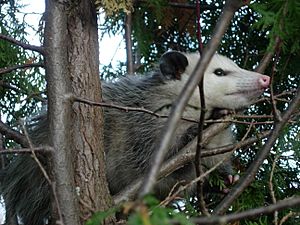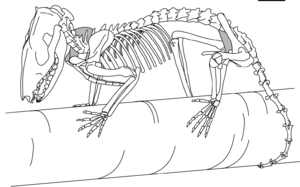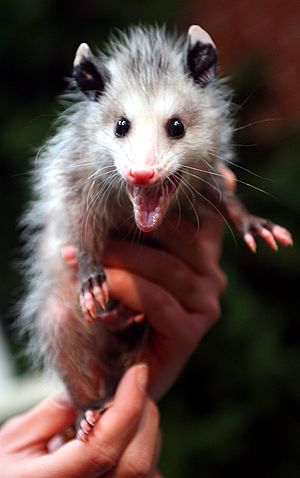Opossum facts for kids
Quick facts for kids DidelphimorphiaTemporal range: Upper Cretaceous – Recent
|
|
|---|---|
 |
|
| Virginia Opossum Didelphis virginiana | |
| Scientific classification | |
| Kingdom: | |
| Phylum: | |
| Class: | |
| Infraclass: | |
| Order: |
Didelphimorphia
Gill, 1872
|
| Family: |
Didelphidae
Gray, 1821
|
Opossums are amazing animals! They are the biggest group of marsupials in North and South America. Their scientific name is Didelphimorphia.
People often call them 'possums,' but that name usually refers to animals from Australia. Opossums are unique to the Americas!
The Virginia opossum was the first animal called an opossum. This word comes from the Algonquian language. It means "white beast." The Virginia opossum was one of the few marsupials from South America to settle in North America. It is the only one still living there today. This happened after a big event called the Great American Interchange.
Contents
What Makes Opossums Special?

Opossums are small to medium-sized marsupials. They can grow to be about the size of a house cat. Most opossums live in trees part-time. They eat many different kinds of food.
Most opossums have long snouts. They also have a narrow braincase and a bony ridge on their head. Opossums walk with their whole foot flat on the ground. Their back feet have a special toe that can grab things. This toe does not have a claw.
Like some New World monkeys, opossums have prehensile tails. This means their tails can grip things. Like all marsupials, their fur is made of special hairs. Female opossums have a pouch for their babies. Parts of their tail and feet have tough scales. Their stomach is simple.
All living opossums eat many different things. They are omnivores. This means they eat both plants and animals. But different kinds of opossums eat more meat or more plants. Some opossums mostly eat fruit. Others, like the lutrine opossum, mainly eat other animals.
The yapok (Chironectes minimus) is very special. It is the only marsupial that lives in water. It has webbed back feet. It uses them to swim and dive for freshwater snails and crayfish.
Opossum Life Cycle
When baby opossums are born, they are tiny. They must crawl into their mother's pouch. There, they attach to a teat to drink milk. Baby opossums are called joeys, just like kangaroos!
Female opossums often have many babies at once. Not all of them survive. But as many as thirteen joeys can attach to a teat and live. The young opossums stay in the pouch for about 70 to 125 days. Then they leave the pouch and stop drinking milk.
Opossums have a very short lifespan for a mammal their size. They usually live only one to two years in the wild. In zoos, they can live four years or more. They get old very quickly.
Male opossums are usually a bit bigger and heavier than females. They also have larger canine teeth.
Opossum Behavior
Opossums usually live alone. They move around a lot. They stay in one place as long as there is enough food and water. Sometimes, opossum families will stay together. They might live in old burrows or even under houses.
Opossums do not dig their own burrows. They use burrows that other animals left behind. They like dark, safe places. These can be underground or above ground. Opossums are active at night.
When an opossum feels scared, it might "play possum". This means it pretends to be sick or dead. It's not something they choose to do. It's an automatic reaction, like fainting. Baby opossums sometimes cannot "play dead" when they are threatened.
When an opossum "plays possum," its lips pull back. Its teeth show. Foamy drool comes from its mouth. Its eyes close or half-close. It also lets out a bad-smelling liquid. The opossum will be stiff and curled up. You can poke it or move it, and it won't react. It usually wakes up after a few minutes to four hours. The first sign it's waking up is a slight twitch of its ears.
Some opossums can use their tails to hold onto things. Young opossums often hang by their tails. An opossum might also use its tail to help it climb. It can even use its tail to carry leaves or bedding material to its nest. A mother opossum sometimes carries her babies on her back. They hold on tight even when she climbs or runs.
Scared opossums, especially males, will growl loudly. The sound gets higher if they are very scared. Male opossums make a clicking sound when they look for a mate. Females sometimes make the sound back. Baby opossums make a sneezing sound if they are lost or scared. Their mother will make the clicking sound to help them find her. If a baby opossum is scared, it will open its mouth and hiss quietly.
What Opossums Eat
Opossums eat many different things. They eat dead animals, insects, rodents, and birds. They also eat eggs, frogs, plants, fruits, and grains. Opossums need a lot of calcium. So, they eat the bones of small animals and roadkill. They also eat dog food, cat food, and human food waste.
Where Opossums Live
Opossums live in North, Central, and South America. The Virginia opossum lives as far north as Canada. It also lives as far south as Central America. Other types of opossums only live in countries south of the United States.
The Virginia opossum often lives in wooded areas. But it can live in many different places. Opossums have been moving further north in recent years. This is probably because of climate change.
Opossums and People
The Virginia opossum was once hunted and eaten a lot in the United States. People even had opossum farms in the past. In the southern U.S., sweet potatoes were often eaten with opossum meat. President Jimmy Carter used to hunt opossums.
In some Caribbean countries, like Dominica and Trinidad, the common opossum is popular to eat. But people can only hunt it at certain times of the year. This is to prevent too much hunting.
Opossum meat is usually smoked, then stewed. It is light and fine-grained. But special glands must be removed when preparing it. The meat can be used in recipes instead of rabbit or chicken.
In Mexico, opossums are called "tlacuache." Some people believe eating their tails can help with fertility. In the Yucatán, they are called "och" in the Yucatec Maya language. Mayan people do not usually eat them. But they are considered food during times of hunger.
Opossum oil has been used as a rub for chests and for arthritis pain. Opossum fur has also been part of the fur trade for a long time.
Images for kids
-
D. virginiana range, including introductions in the west. Currently these areas are expanding northwards (e.g., into Wisconsin and Minnesota).
See also
 In Spanish: Didélfidos para niños
In Spanish: Didélfidos para niños






